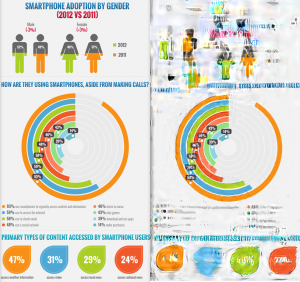Sharing case studies with your target audience is a powerful way to reinforce the value of your products or services.
When well written as a captivating customer story, that value transfers over to the reader and helps them identify with the incorporated challenge. It will also show them solutions and potential outcomes that are successful.
If you are not already using these case studies to enhance your marketing strategy, it is time to start.
In other words, you need to create captivating case studies, or customer stories, that sell your brand, product, or service for you through the real-life experiences of another.
While one strategy may be to create a case study template to save time, a more beneficial approach is to tailor each customer story, avoiding the one-size-fits-all approach.
Below you will find helpful information on why this is necessary and how to craft your own case studies that read more like a story than a reiteration of facts and results.
What Is a Business Case Study?
A business case study is a summary of a real-life business scenario where steps are taken to solve a problem effectively.
Also called customer stories, they show how your business has made a real and significant impact on your customers. These scenarios can help show potential customers what your brand is able to do for them.
Differently than an advertisement or press release, it should focus mainly on the customer’s journey, not on the company.
A case study is a story about how the customer overcame certain problems or challenges thanks to your products or services. At its core, it is an in-depth analysis of problems and solutions. It examines the challenges and presents answers that tie back to your company.
How Can Case Studies Benefit Your Brand?
Consumers have become very savvy and today’s modern consumer wants to do their own research and make decisions without a salesperson or advertisement telling them what to think or what to buy.
Around 96% of people in the U.S. shop online and more than 63% do online research prior to making a purchase. This opens the door for your brand to put educational material in the hands of consumers, providing them with the information they need to make informed decisions regarding your business.
Case studies can be extremely beneficial for this purpose in a number of ways.
Put your product or service value into action
The case study walks the reader through the conflict the customer experienced, what they tried, and how they ultimately used your product or service to solve it. A good case study is an engaging story that is very relatable – and that is what makes it so effective.
It takes the reader on a very specific journey that is centered around using a specific service or product. It takes that value and puts it into action. This is what your prospective customers need to see because they can then envision how your product or service will work for them.
Highlight the benefits and features of your product or service
Nearly every product or service has several specific benefits and features.
Each of our customers may use your product in a different way, taking advantage of those features and benefits. Case studies that are focused on a particular feature can show how your customer benefitted from it and how they used it.
This gives you more real-world illustrations for the application of your product or service.
Elicit trust and credibility using peer influence
The best marketing strategy that a business can have is word of mouth.
Customers in the United States are far more likely to purchase from a brand that someone they know has recommended. Word-of-mouth marketing is what marketers work hard for, what they seek, and what can propel a brand from obscurity into a household name.
Many other types of content are typically self-serving, but case studies are all about the customer. When an actual customer opens their mouth, they become a third-party brand endorsement which encourages trust and loyalty.
Any type of endorsement has some value, and case studies are no different. The more details you provide, the more qualified leads you will attract, and the more customers you will have.
Attract qualified leads and convert more
Research surrounding case studies and related types of peer recommendations shows that they are very effective in not only attracting customers but attracting the right types of customers.
97% of B2B customers rely on peer-recommended content, including case studies, citing them as the most reliable type of content. When it comes to consumers, 88% trust case studies and other types of peer-recommended material as much as they trust recommendations from their family or friends.
Incorporating case studies into your marketing campaigns and customer onboarding trails will allow your prospects to see real-world scenarios showing how your products are being used to solve real problems.
If a customer or prospective customer is having trouble in a certain area, one of your representatives or salespeople can refer to the case study that lines up the best with the prospect’s problem. The prospect can then see how others have handled the problem by utilizing your products or services.
Main Types of Case Studies for Business
A business case study is not just a generalized term, a one size fits all marketing ploy. It is a highly specialized type of content that can breathe new life into your brand and become a vital part of your business strategy.
There are four main types of case studies:
Critical Instance Case Study
This type of study answers cause-and-effect questions. It examines a situation in a very detailed manner with a key characteristic of avoiding generalization and universal assertions.
Cumulative Case Study
This type of study aggregates information from several sources that occurred at different times.
Exploratory Case Study
Also known as a pilot case study, this is a condensed version that precedes a more in-depth analysis. It is primarily used to aid in determining types of measurement and identifying questions before launching the main research.
Illustrative Case Study
This type of study is mostly focused on being descriptive and is the type that is most commonly associated with case studies. It outlines the problem, usually one or two situations to illustrate the challenge, then move on to the solution.
Within each of these types, one or more areas of business may be explored, including:
- Growth Plan or Strategy
- Industry Landscape & Competitor Dynamics
- Market Entry or Expansion
- Merger, Acquisition, or Joint Venture
- New Product
- Pricing Optimization
- Profitability Optimization
- Start-Up or Early Stage Venture
There are also types of case studies that are developed internally and used to analyze various areas of the organization, market, or industry. They are used to assess problems within a company and find viable solutions.
These are not used for marketing purposes. Instead, they are used as a way for a business to maximize profitability, optimize growth, and determine the suitability of an industry for entry or exit.
The Anatomy of a Business Case Study
A business case study is a narrative that showcases your company’s success. Similar to any story, it comprises essential elements that engage readers and guide them toward a desired action.
Let’s explore the key components of a case study and how to create a captivating narrative.
Introduction: The beginning of the journey
Start with an intriguing introduction that hooks the reader and sets the stage for the story. Provide a glimpse of what lies ahead, arousing curiosity and interest.
This section should establish the context and outline the problem your customer faced.
The Middle: Unfolding the story
The middle section is where the main story unfolds. Introduce the customer as the protagonist, and outline the challenges or problems they encountered. Demonstrate how they discovered your company and its product or service as a potential solution.
Engage the reader by allowing them to empathize with the customer’s struggles and envision themselves in a similar situation.
The End: A satisfactory conclusion
Conclude the case study with a strong ending that ties everything together. Highlight the successful outcome achieved by the customer through their collaboration with your company.
Emphasize the specific areas of improvement, such as increased profitability, enhanced production, or accelerated growth.
This section should inspire readers and leave them with a clear call to action.
How to Produce a Case Study: A Step-by-Step Guide
As we’ve shown so far, case studies can be an effective tool to showcase your business’s success and build credibility with your audience.
Here’s a comprehensive guide on how to produce a compelling case study:
1. Selecting candidates
Start by identifying customers who have expressed satisfaction with your solution.
Look for feedback on social media, emails, phone calls, or video chats. Reach out to them via email, explaining that you’d like to feature their success story in a case study.
Ask about their experience with your product or service, how they discovered your business, and the results they achieved.
2. Conducting interviews
Once you’ve chosen suitable candidates, inform them about their selection.
Set up an interview either in person, over the phone, or through a video call. Explain that you value their partnership and that they only need to answer a few questions—assure them that their picture won’t be used.
Seek permission to publish their name and relevant business information. Ensure you have formal authorization to publish their information.
During the interview, ask questions such as:
- What challenges did you face before using our solution?
- How did you discover our business?
- What made you choose our solution?
- Were there any implementation difficulties? How did you overcome them?
- What results did you achieve after using our solution?
- How did your business transform as a result?
3. Organizing information
After conducting interviews, you’ll have a wealth of information to organize. You can structure the content in the following manner:
- Title: Create an intriguing title that highlights your customer’s achievement and your solution.
- Abstract: Summarize the case study in two to four lines.
- The Customer: Introduce the customer and provide an overview of their business.
- The Challenge: Explain the specific challenges the customer faced.
- The Solution: Describe how your solution addressed their needs.
- The Results: Present concrete results using numbers and statistics.
- Quotations: Include impactful quotes from the customer.
- Images and Graphics: Use photos or graphics to illustrate key points.
4. Engaging with storytelling
To make your case study more interesting and engaging, incorporate storytelling techniques.
Instead of focusing solely on your brand, make your customer the protagonist. Use the hero’s journey narrative structure to captivate your audience. Highlight the moment of struggle, the mentor (your business) that helped, the journey to overcome obstacles, and the ultimate transformation that occurred.
This approach will create a stronger emotional connection with your audience.
5. Using interactive content
Interactive features encourage active participation from your audience and increase the chances of them progressing through the buyer’s journey.
Interactive maps, graphs, and sheets can improve the data visualization in the case study. Using such features also demonstrates your commitment to providing valuable content and helping build trust with your audience.
6. Finalizing and distributing the case study
Once you have created the content, seek approval from the featured customer.
Determine the appropriate platform to release the case study based on your target audience’s preferences and behaviors.
Consider adding it to a dedicated page on your website, blog posts, landing pages, or social media campaigns.
12 Tips for Crafting Impactful Customer Stories
The more detailed your case story is, the more likely it will become to resonate with your target audience. Let’s move this conversation to a new level by looking into some tips to develop a great structure for your customer story.
1. Be authentic
Use conversational language and avoid jargon or buzzwords. Communicate in a way that resonates with your audience and fosters a genuine connection.
2. Understand your audience
Consider your target audience’s interests and pain points. Address their concerns and demonstrate how your product or service addresses their specific needs.
Create a profile of your ideal customer and write the case study specifically for them. Consider what their pain points are and how your solution could impact their business.
3. Point out key features
Highlight one or two key features of your offering that played a significant role in solving the customer’s problem. Clearly articulate how these features made a difference.
4. Show value
Illustrate the value your product or service brings beyond the immediate solution. Explain how it positively impacts the customer’s bottom line, productivity, or overall business objectives.
5. Choose a focus
Identify three key takeaways you want readers to glean from the case study. Ensure these points are effectively conveyed throughout the story, aligning with your strategic messaging.
6. Utilize data and statistics
Incorporate verifiable data, dollar amounts, and measurable statistics whenever possible. These elements enhance credibility and reinforce the impact of your solution.
Incorporate specific numbers and statistics to lend credibility to your case study. Instead of vague statements, provide tangible results based on real data.
7. Highlight humanity
Make the story relatable by showcasing the human side of the situation. Share personal anecdotes or experiences that humanize the challenges and victories.
8. Include customer quotes
Whenever feasible, include quotes from the customer to add authenticity and provide a personal touch to the case study.
9. Avoid direct praise
While testimonials are valuable, refrain from overtly praising your own company within the case study. Let the customer’s success story speak for itself.
10. Keep it simple and easy to read
Use a format that is easy to read, with short paragraphs, white space, and images to break up the text. Utilize bulleted lists and emphasize key points with bold or italicized text.
Format your case study in a visually appealing way, using headers, bullet lists, and bold text to guide the reader’s attention. Include images to enhance comprehension and engagement.
11. Repurpose your case studies
Extend the reach of your case studies by repurposing them into different formats. Turn them into blog posts, social media teasers, infographics, or emails to engage with different audiences.
Explore different formats for your case study, such as interviews, videos, podcasts, or infographics. This allows you to reach a wider audience and cater to different preferences.
12. Make your case study easy to find
Implement a strategy to ensure your case studies are easy to find. Place them prominently on your website, optimize them for search engines, and promote them through various channels to maximize exposure.
Ensure that your case studies are easily accessible to prospective customers. Create a dedicated page on your website or include them in your resources section. Promote them through social media and email marketing to maximize visibility.
Successful Case Study Examples
A beneficial way to begin creating your own case studies is to look at other offerings already out there. From these, you can discover what you like or dislike about them and tailor a strategy for how to present yours in an engaging and captivating way befitting your particular brand voice. Here are a few to get you started.
How 6Connex Doubled Their Traffic and Increased Their CTR by 25% In Just One Year
Seeking to gain a status of higher authority within the exploding virtual events industry, 6Connex examined the content they were currently offering, assessed performance, and began to refine their SEO strategy.
The marketing team concluded that what they needed was more long-form content to meet the goal of providing customers with in-depth information to further position them as an authority in their field.
Partnering with Rock Content’s WriterAccess, 6Connex outsourced their blog writing to experienced content creators already knowledgeable in event planning. These content creators took over the numerous tasks of writing SEO-strategized blog posts, creating authoritative long-form content in less time than it would have taken their in-house marketing team.
As a result, 6Connex saw a doubling of web traffic, a 35% boost in page views, and a 25% increase in click-through rates (CTRs).
What stands out in this case study is the way in which it is told.
It provides a glimpse of how the need for long-form content arose, how they sought to resolve it efficiently, and future plans to continue a consistent offering of authoritative content going forward.
Overall, the case study shows how working with Rock Content’s WriterAccess is a complementary addition to their own in-house efforts to improve SEO and position themselves as an authority in the virtual events planning industry.
A few things to take away from this case study and to incorporate into your own include:
- Show the value of your product or service, as this one shows the value of WriterAccess services.
- Mention your product or service early on in the case study and provide a way for readers to learn more (e.g., anchor text with a link).
- Make it more personal by incorporating quotes (in this case, the informative quotes come directly from the marketing coordinator). By including customer quotes, it shows that you reached out to the client directly and included important parts of that interview to tell the story.
- Avoid direct praise for your company, product, or service. Remember, case studies are about the customer, not you.
- Make your case study simple and easy to read.
- Insert visuals showcasing the achieved results.
- Insert a CTA at the bottom of your case study that ties in with the services and results of the case study itself.
Korn Ferry Engages Audiences and Improves User Experience with Data-Driven Content
Global organizational consulting firm Korn Ferry consists of three business lines, all of which require their own unique content. This task alone challenged their in-house marketing team, stretching them thin when attempting to create insightful content for each one. Another issue facing the firm was how to capture more information about potential leads.
This case study lays out the marketing challenges faced by Korn Ferry in a storytelling fashion, relatable to others in a similar position.
Many companies face the challenge of generating new leads and obtaining more information about prospects to fuel their marketing strategy. Because of this, viewers will naturally want to keep reading to find out how Korn Ferry sought out a solution.
That solution turned out to be partnering with Ion to create more interactive content to drive engagement. This interactive content included quizzes, calculators, and more. They also were able to improve the audience experience for one of their white papers by breaking it up into interactive chapters. By doing so, they could better ascertain which parts were receiving the most attention.
Overall, the addition of interactive content provided a way to collect more data about their audience, find high-quality leads, and improve the overall user experience.
Examples of key takeaways from this case study include;
- Mention the key result in the title of the case study to entice curiosity and a desire to keep reading.
- Point out key features of the service or product (Ion) and what the customer is able to accomplish with them.
- Provide details surrounding how the client worked with the product or service to achieve its goals.
- Structure a case study in a way that guides the reader through the story. For example, start with information on the company, then segway into the challenge, the content, and the data that led to successful outcomes (e.g., more useful marketing communications). Break up the text with a mix of headings and subheadings.
- Show the value of the product or service and what the customer accomplished by using it.
Create Compelling Case Studies with WriterAccess
Case studies can serve as an effective and robust tool to showcase your company’s ability to help customers achieve success. There is, however, a skill to crafting such compelling and captivating case studies that speak to your target audience and help them see themselves in a similar type of situation.
For help with the writing of these beneficial marketing tools and any other content, you may need, your company and marketing team can easily partner with WriterAccess and its range of experienced writers.
To experience how the process works, explore our talented pool of writers, and see first-hand the type of content we can produce, sign up for our expansive 14-day free trial today.







